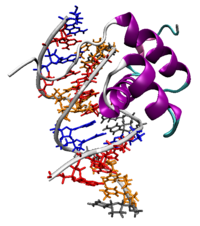
Human ERG oncoprotein represses a Drosophila LIM domain binding protein-coding gene Chip.
Sign Up to like & getrecommendations! Published in 2023 at "Proceedings of the National Academy of Sciences of the United States of America"
DOI: 10.1073/pnas.2211189119
Abstract: Human ETS Related Gene, ERG, a master transcription factor, turns oncogenic upon its out-of-context activation in diverse developmental lineages. However, the mechanism underlying its lineage-specific activation of Notch (N), Wnt, or EZH2-three well-characterized oncogenic targets… read more here.
Keywords: represses drosophila; lim domain; erg; domain binding ... See more keywords

Immune Stimulation of RAP domain binding protein (rTgRA15) from Toxoplasma gondii
Sign Up to like & getrecommendations! Published in 2018 at "Pathogens and Global Health"
DOI: 10.1080/20477724.2018.1536854
Abstract: ABSTRACT Toxoplasmosis, a parasitic disease in human and animals, is caused by Toxoplasma gondii. Our previous study has led to the discovery of a novel RAP domain binding protein antigen (TgRA15), an apparent in-vivo induced… read more here.
Keywords: protein; gondii; domain binding; binding protein ... See more keywords

Tight junction formation by a claudin mutant lacking the COOH‐terminal PDZ domain‐binding motif
Sign Up to like & getrecommendations! Published in 2022 at "Annals of the New York Academy of Sciences"
DOI: 10.1111/nyas.14881
Abstract: Claudin‐based tight junctions (TJs) are formed at the most apical part of cell–cell contacts in epithelial cells. Previous studies suggest that scaffolding proteins ZO‐1 and ZO‐2 (ZO proteins) determine the location of TJs by interacting… read more here.
Keywords: pdz domain; binding motif; terminal pdz; domain binding ... See more keywords

WW domain binding protein 2 (WBP2) as an oncogene in breast cancer: mechanisms and therapeutic prospects—a narrative review
Sign Up to like & getrecommendations! Published in 2022 at "Gland Surgery"
DOI: 10.21037/gs-22-716
Abstract: Background and Objective WW domain binding protein 2 (WBP2), considered an emerging breast cancer gene, functions as a binding partner for WW domain proteins. The WBP2 gene is involved in mediating the malignant development and… read more here.
Keywords: binding protein; breast; domain binding; breast cancer ... See more keywords

Homology modeling, virtual screening, molecular docking, and dynamics studies for discovering Staphylococcus epidermidis FtsZ inhibitors
Sign Up to like & getrecommendations! Published in 2023 at "Frontiers in Molecular Biosciences"
DOI: 10.3389/fmolb.2023.1087676
Abstract: Staphylococcus epidermidis is the most common cause of medical device-associated infections and is an opportunistic biofilm former. Among hospitalized patients, S. epidermidis infections are the most prevalent, and resistant to most antibiotics. In order to… read more here.
Keywords: staphylococcus epidermidis; inter domain; domain binding; ftsz inhibitors ... See more keywords

LIM-Domain-Binding Protein 1 Mediates Cell Proliferation and Drug Resistance in Colorectal Cancer
Sign Up to like & getrecommendations! Published in 2021 at "Frontiers in Surgery"
DOI: 10.3389/fsurg.2021.790380
Abstract: Objective: It has been shown that LIM-domain-binding protein 1 (LDB1) is involved in the tumorigenesis of several cancers, but its function in colorectal cancer (CRC) has not been fully explained. This study is aimed to… read more here.
Keywords: drug; ldb1; lim domain; cell ... See more keywords